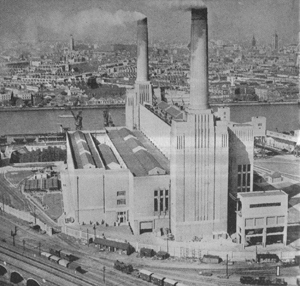History of Battersea Power Station
A new power station
London erupted in a storm of protests when the idea about building a power station on the bank of the River Thames was first mentioned in 1927. There was a sense of nervousness and fear, and Parliament was accused of allowing pollution from the power station to ruin ‘noble London buildings’ near by parks, works of art and even endanger health.
Battersea Power Station 1934 (photo credit: Andy Dingley (scanner) - Scan from Foreword by E. Royston Pike (1938) Our Generation, London: Waverley Book Company, Public Domain).
Fragmented electrical supply
During this time, electricity was supplied by smaller private power stations, but competition between them was chaotic. This led to Parliament agreeing that the generation and supplying of electricity should be a publicly owned, single and unified system. And so, electricity became nationalised and the Power Station was built, becoming an iconic landmark on the south bank of the River Thames today, with the history of supplying electricity to London for over 50 years.
The largest power station in the UK
Battersea Power Station was the first of its kind, producing 400,000 kilowatts of electricity in Battersea. Sir Giles Scott, renowned for his architectural work on Waterloo Bridge, Liverpool Cathedral and the red telephone box was commissioned to design the building. After a two stage development process, the Power Station was completed by the British Electric Authority in 1948 and began operating in 1953, with the highest thermal efficiency. Battersea Power Station became known as the ‘temple of power’, the largest power station in the UK.
Disrepair and redevelopment
The Power Station was renowned for its unique, lavish Art Deco interior, and its grand size and beauty. However in 1983 the building closed down, and remained largely unused ever since. The whole structure became Grade II* listed in 2007. Since the closures, numerous redevelopment plans were made but none were successful until 2012 when it was announced that Malaysian investors SP Setia and Sime Darby would redevelop the site to reflect the designs of Rafael Viñoly. Today, history is being made once again.

The vision for Battersea Power Station.
